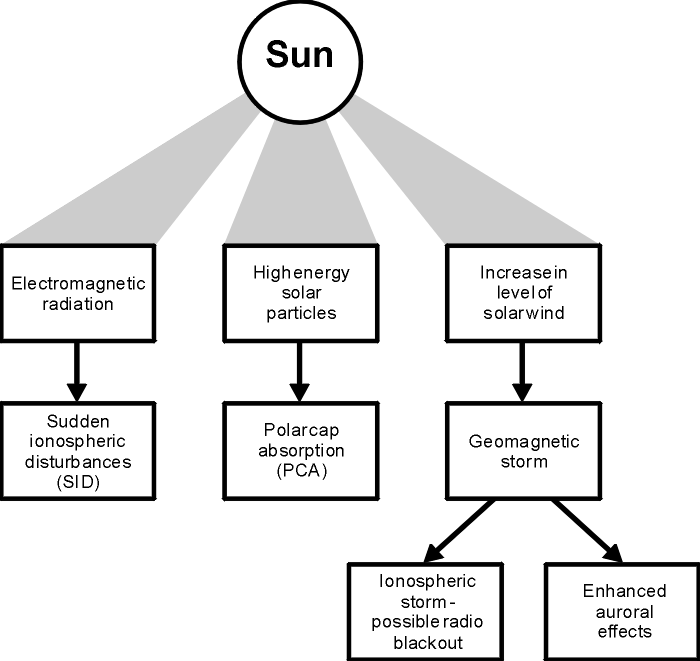Sudden Ionospheric Disturbance, SID
Overview of the sudden ionospheric disturbance, SID, that affects HF radio signal propagation
Home » Antennas & Propagation » this page
Solar effects on propagation includes:
The Sun & its structure
Sunspots
Solar disturbances
SID sudden ionospheric disturbance
Auroras & propagation
Ionospheric propagation:
Ionospheric propagation
As electromagnetic waves, and in this case, radio signals travel, they interact with objects and the media in which they travel. As they do this the radio signals can be reflected, refracted or diffracted. These interactions cause the radio signals to change direction, and to reach areas which would not be possible if the radio signals travelled in a direct line.
Sudden Ionospheric Disturbances or SIDs are often experienced on the HF or short wave bands where they may also be called blackouts, short wave fades (SWF), or they are sometimes referred to as the Dellinger effect, after the person who first noted them. As the name implies they occur suddenly, and they cause a blackout of ionospheric radio propagation for a number of hours. This may cover part, or even all of the HF radio spectrum.
Sudden ionospheric disturbance cause
There are a number of types of blackout that may be experienced on the HF bands. Sudden Ionospheric Disturbances, SID, only last for a few hours, but they may be the precursor for a longer blackout. Generally a SID is caused by a large solar flare (M or X class - see the article on Solar Disturbances on this website). Along with the flare there is a massive increase in the level of radiation that is emitted by the Sun. It takes just over 8 minutes for the radiation from the Sun to reach the Earth, at which point the effects start to be noticed and the SID begins. As light takes the same time to reach the Earth, there is no prior warning of an event happening.
The radiation from the Sun caused by the flare is not limited to one form of radiation, but it includes all forms including a high level of X-rays. The X-rays are able to penetrate through to the D layer or D region of the ionosphere and as a result they give rise to a high level of ionisation in the D region. This results in a very significant increase in the level of D region attenuation.
Although the increase in the level of radiation is rapid, it takes time for the level of ionisation to rise. As a result the lower frequencies are affected first, and as the degree of ionisation increases, so the higher frequencies are affected. During a normal day the D region normally affects frequencies up to two or three MHz, but the increase in radiation from a flare can cause much higher frequencies to be affected. Often it can result in a complete black out of the HF bands. At other times a SID may only affect the lower frequencies.
SID related effects
There are a number of other side effects that may be noticed, especially at the onset of a Sudden Ionospheric Disturbance, SID. The D region is affected by the large increase in X-rays, but other forms of radiation, including ultra-violet also increase in intensity. This gives rise to an increase in the degree of ionisation in the higher regions of the ionosphere. This can result in an increase in the maximum usable frequency, especially at the beginning of a radio blackout when the D region attenuation is not as high.

Sudden ionospheric disturbance duration
A SID may last only a few hours. As recovery starts, the high frequencies are affected first. After the flare as the level of radiation falls, so will the D region ionisation. As its intensity falls, so it will affect the higher frequencies less, and HF propagation conditions will slowly return to normal unless they are part of a larger disturbance.
It is also worth noting that it is only the sunlit side of the earth that is affected. Any areas that were in darkness when the flare occurred escape the effects. A further effect of a flare is that at the same time as the X-ray radiation reaches the Earth giving rise to a blackout, it is found that noise bursts from the increased levels of radio frequency radiation may be monitored at VHF.
 Written by Ian Poole .
Written by Ian Poole .
Experienced electronics engineer and author.
More Antenna & Propagation Topics:
EM waves
Radio propagation
Ionospheric propagation
Ground wave
Meteor scatter
Tropospheric propagation
Antenna basics
Cubical quad
Dipole
Discone
Ferrite rod
Log periodic antenna
Parabolic reflector antenna
Phased array antennas
Vertical antennas
Yagi
Antenna grounding
Installation guidelines
TV antennas
Coax cable
Waveguide
VSWR
Antenna baluns
MIMO
Return to Antennas & Propagation menu . . .


